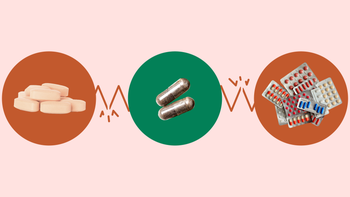
What Does Creatine Do? Overview, Benefits, and Side Effects
Key takeaways:
Creatine is a popular performance-enhancing supplement among athletes. But it may have other clinical uses.
Creatine supplements can safely increase muscle mass and enhance exercise performance.
Creatine supplements are generally well tolerated. Their most common side effect is weight gain.
Table of contents

What is creatine?
Creatine is a type of amino acid that is made by the liver and kidneys and mostly stored in the muscles. It serves as an energy source for the body, especially for the skeletal muscles. These are the muscles that attach to bones and help you move your body. Creatine can also be stored in brain tissue.
Creatine is found in certain foods naturally, as well as in dietary supplements (more on this below).
What does creatine do?
Creatine helps give your body’s muscles energy and strength. Your muscles store creatine in the form of creatine phosphate. When the body needs a sudden burst of energy, the muscles convert the creatine phosphate into energy-carrying molecules. Because of this, creatine supplements are often used for improving athletic performance and enhancing muscle mass.
Search and compare options
Dietary sources of creatine
Foods that are high in creatine are animal-based foods that contain protein. Dietary sources of creatine include:
Meat, especially red meat
Fish, such as herring, salmon, and tuna
Poultry, like chicken or turkey
Milk, including breast milk or cow’s milk
Plant-based foods do not contain any creatine.
Supplement sources of creatine
Creatine supplements come in various forms. The most popular is powder. Creatine monohydrate in powder form has also been studied the most extensively.
Other forms, such as creatine salts and premade creatine beverages, are made because the powder form doesn’t dissolve in liquid very well. But these other forms have not been well studied. And the few studies that exist seem to show that the powder form is most effective.
Creatine benefits
People often use creatine supplements to help with athletic performance. So creatine has been widely studied in athletes. But in the past few decades, scientists have uncovered other possible health benefits.
Read more like this
Explore these related articles, suggested for readers like you.
Creatine may improve athletic performance
Creatine supplementation may:
Improve exercise performance
Increase muscle mass and strength
Increase exercise tolerance
Help with post-exercise recovery
Help prevent muscle injuries after exercise
Creatine may help your muscles and brain as you age
Aging is associated with lower levels of creatine, especially in the muscles. As you age, creatinine may help:
Prevent age-related loss of muscle mass and strength — this effect is much stronger when combined with resistance training
Improve memory and brain function in older adults
Help prevent bone loss, though the research on the effect on bone health is mixed
Creatine may help treat neurological and muscular disorders
Animal studies have shown that creatine can help treat the symptoms of neurological disorders such as Huntington’s disease, Parkinson’s disease, and stroke. However, we don’t have good studies in humans to show that creatine is effective for these conditions.
There is evidence that creatine can also improve muscle strength and the ability to perform daily physical activities in people with muscular dystrophies.
Creatine may help treat recovery from head injury
In a randomized controlled trial, children who were given creatine after a traumatic brain injury had fewer headaches, dizziness, and fatigue than children who were not given creatine. They also spent less time in the intensive care unit and had fewer memory problems.
Further studies are being conducted to understand more about what role creatine might play in the prevention of concussion symptoms after a traumatic brain injury.
Creatine can treat certain genetic disorders
Creatine supplementation also helps treat some types of creatine deficiency disorders. These are disorders in which creatine is not made or transported properly in the body. These rare disorders are usually diagnosed in early childhood.
Creatine can increase muscle mass and weight
Creatine can increase muscle fiber size and lean muscle mass. So it can make your muscles bigger. However, there are some important caveats. One large meta-analysis found that creatine can increase muscle size, but only when it’s combined with effective exercise training. Also, creatine’s effect on muscle size is much stronger in younger adults than older adults.
Creatine side effects
The main side effect of creatine seen in clinical studies is weight gain. While some healthcare providers are concerned about other potential side effects — like muscle and kidney damage — most studies on the effects of creatine have not found significant side effects at recommended dosages.
Some people report experiencing certain side effects while taking creatine supplements, even if clinical trials haven’t confirmed those side effects are common in larger groups of people. Reported side effects from creatine include:
Nausea
Diarrhea
Muscle cramps or stiffness
Trouble tolerating hotter temperatures
Creatine and weight gain
Creatine can lead to weight gain in some people. Many people think this is due to water retention. Some studies have shown that you may retain more water in the short term. But people who take creatine for 4 or more weeks do not seem to have increased retention of water overall. So researchers concluded it is more likely that the weight gain is related to increased muscle mass.
Does creatine damage the kidneys?
It’s unclear. Some people worry that taking creatine can damage the kidneys because it can cause a temporary elevation in creatinine (which can be a sign of reduced kidney function). But it’s important to note that athletes tend to have higher levels of creatinine during intense training, which can be present whether or not they take creatine. And multiple studies have found that taking creatine does not cause any problems in kidney function. This seems to be true with both short-term and long-term creatine supplementation.
However, these studies have been done in healthy people without any underlying kidney problems. How creatine affects people with kidney disease isn’t as well studied. For this reason, creatine is not recommended for people with known kidney problems.
Does creatine cause muscle damage?
There have been case reports of people who took high doses of creatine and developed
rhabdomyolysis. This is a condition in which damaged muscle tissue releases proteins into the bloodstream. This can be very harmful to the kidneys and other organs in the body. Clinical trials haven’t shown rhabdomyolysis to be more common in people who take creatine compared to people who don’t.
Anyone who works out aggressively is at risk for rhabdomyolysis, so drinking plenty of water and avoiding excessive heat during workouts is important.
Is creatine safe?
Most experts regard creatine as safe. The International Society of Sports Nutrition (ISSN) released a position statement stating that creatine is a safe, effective, and well-studied supplement. They argue that creatine is one of the few nutritional supplements for which research has consistently shown benefits along with a good safety profile. The FDA puts creatine in the category of “generally recognized as safe.”
Is creatine safe in children and adolescents?
More research in children and adolescents is needed before scientists can say for sure.
The American Academy of Pediatrics and The American Academy of Orthopedic Surgeons do not recommend the use of creatine in people under the age of 18. This is because there haven’t been enough studies in children to understand the potential long-term health risks. But creatine is still popular in young athletes — including adolescents. According to a 2001 survey, around 16% of teenage athletes in the U.S. reported using creatine in the past.
A few small studies reported that creatine helped improve athletic performance in teenage swimmers and soccer players without significant side effects. But better research is needed to know more about the safety profile in this age group.
Creatine interactions
There aren’t many studies that focus on medication interactions with creatine supplements.
However, some experts suggest caution when using creatine if you take medications that are hard on the kidneys. In this case, you may want to talk to your healthcare provider about whether creatine is safe for you.
Examples of medications that can affect kidney function include:
Nonsteroidal anti-inflammatory medications (NSAIDs), such as ibuprofen (Advil, Motrin) and naproxen (Aleve)
Diuretics (water pills), such as hydrochlorothiazide and furosemide (Lasix)
Angiotensin-converting enzyme (ACE) inhibitors, such as lisinopril
These aren’t the only medications that can affect your kidneys. Be sure to provide a full list of medications and supplements you take to a healthcare provider or pharmacist, so they can help you determine whether creatine supplements are safe for you.
Creatine supplement dosage
According to the ISSN, the following creatine dosage is safe:
Creatine monohydrate at 0.3 grams per kilogram of body weight per day for 5 to 7 days, split into 4 doses throughout the day (called a “loading dose”)
After the loading dose period ends, 3 to 5 grams per day for up to 5 years
That said, studies suggest that a loading dose isn’t necessary to get the full effects of creatinine. People who took 3 to 5 grams per day for 28 days had the same amount of creatinine in their muscle as people who took 20 grams per day for 6 days. The main difference between the two dosage schedules is that the loading dose is a faster way to achieve those results. However, since the effect is ultimately the same, many experts recommend skipping the loading dose stage.
The bottom line
Creatine has been used for decades to help with athletic performance, and people commonly take it for muscle function. It can increase muscle mass, strength, and performance. But it is also being studied as a way to help with various health issues, ranging from treatment of traumatic brain injury to neurological diseases in adults. While there are concerns about the potential for side effects, clinical trials have not found significant side effects in people who take creatine at the recommended dosage.
Why trust our experts?



References
Antonio, J., et al. (2021). Common questions and misconceptions about creatine supplementation: What does the scientific evidence really show? Journal of the International Society of Sports Nutrition.
Boccanegra, B., et al. (2020). Safety issues and harmful pharmacological interactions of nutritional supplements in Duchenne muscular dystrophy: Considerations for standard of care and emerging virus outbreaks. Pharmacological Research.
Bødker, R. L., et al. (2023). Pilot study protocol of a randomized controlled trial for the potential effects of creatine monohydrate on persistent post-concussive symptoms. Frontiers in Neurology.
Buford, T. W., et al. (2007). International Society of Sports Nutrition position stand: Creatine supplementation and exercise. Journal of the International Society of Sports Nutrition.
Candow, D. G., et al. (2013). Creatine supplementation and aging musculoskeletal health. Endocrine.
Candow, D. G., et al. (2019). Effectiveness of creatine supplementation on aging muscle and bone: Focus on falls prevention and inflammation. Journal of Clinical Medicine.
Centers for Disease Control and Prevention. (2023). Rhabdomyolysis.
Jagim, A. R., et al. (2021). Creatine supplementation in children and adolescents. Nutrients.
Kley, R. A., et al. (2013). Creatine for treating muscle disorders. Cochrane.
Kreider, R. B., et al. (2003). Long-term creatine supplementation does not significantly affect clinical markers of health in athletes. Molecular and Cellular Biochemistry.
Kreider, R. B., et al. (2017). International Society of Sports Nutrition position stand: Safety and efficacy of creatine supplementation in exercise, sport, and medicine. Journal of the International Society of Sports Nutrition.
Mendes, R. R., et al. (2002). Creatine: The nutritional supplement for exercise - current concepts. Latinoamericanos de Nutricion.
Mercimek-Andrews, S., et al. (2022). Creatine deficiency disorders. GeneReviews.
Metzl, J. D., et al. (2001). Creatine use among young athletes. Pediatrics.
National Institutes of Health, Office of Dietary Supplements. (2022). Dietary supplements for exercise and athletic performance.
OrthoInfo. (2020). Creatine supplements. American Academy of Orthopaedic Surgeons.
Ostojic, S. M. (2021). Creatine as a food supplement for the general population. Journal of Functional Food.
Poortmans, J. R., et al. (2000). Adverse effects of creatine supplementation: Fact or fiction? Sports Medicine.
Poortmans, J. R., et al. (2005). Effect of oral creatine supplementation on urinary methylamine, formaldehyde, and formate. Medicine and Science in Sports and Exercise.
Poortmans, J. R., et al. (2012). Adverse effects of creatine supplementation. Sports Medicine.
Rawson, E. S., et al. (2017). Perspectives on exertional rhabdomyolysis. Sports Medicine.
Ray, T. R., et al. (2001). Use of oral creatine as an ergogenic aid for increased sports performance: Perceptions of adolescent athletes. Southern Medicine Journal.
Riesberg, L. A., et al. (2016). Beyond muscles: The untapped potential of creatine. International Immunopharmacology.
Sakellaris, G., et al. (2007). Prevention of traumatic headache, dizziness and fatigue with creatine administration. A pilot study. Acta Paediatrica.
Schoch, R. D., et al. (2006). The regulation and expression of the creatine transporter: A brief review of creatine supplementation in humans and animals. Journal of the International Society of Sports Nutrition.
Smith, R. N., et al. (2014). A review of creatine supplementation in age-related diseases: More than a supplement for athletes. F1000 Research.
U.S. Food and Drug Administration. (2023). Generally Recognized as Safe (GRAS).
Vega, J., et al. (2019). Effects of creatine supplementation on renal function. Revista Medica de Chile.
Wu, S. H., et al. (2022). Creatine supplementation for muscle growth: A scoping review of randomized clinical trials from 2012 to 2021. Nutrients.





























